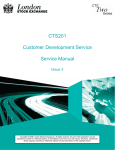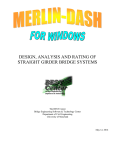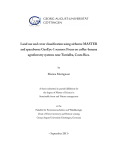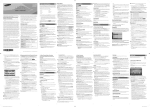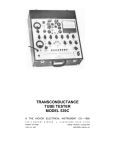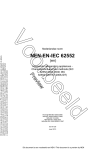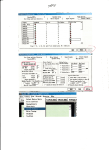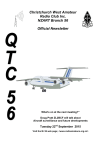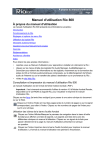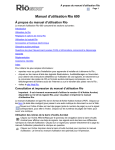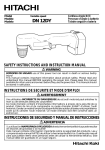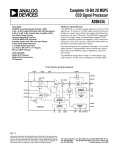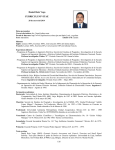Download CTS301 Conformance Test Service
Transcript
CTS301 Conformance Test Service Service Manual Issue 2 Copyright © 2006 London Stock Exchange plc. All rights reserved. No part of the publication may be reproduced, stored in a retrieval system, or transmitted in any form or by any means, electronic, mechanical, photo-copying, recording or otherwise without the prior permission of the copyright owner. Preface Page 1 of 43 CTS301 Conformance Test Service – Service Manual, Issue 2 PREFACE CTS THREE SERIES: CONFORMANCE SERVICE MANUAL The purpose of the CTS Three Series is to provide customers with all the necessary information needed to get the most out of the Conformance Test Services operated by the London Stock Exchange. The CTS Three Series of documents combine together to form a full and detailed “service manual” that provides guidance on using and maximising the features of the Conformance services. These documents give users essential and detailed information needed to understand and use the Conformance Test Service, which allows customers to prove the interface between their systems and the Exchange’s Trading and Information systems. The tests cover a range of functional areas and ultimately prove user’s systems can interact and behave as specified with the Exchange’s core architecture. The documents are divided in to discreet silos in order to make the detailed and vast amount of information more manageable and accessible. The following are covered: x General service information and guidance on each test facility available within Conformance, including service descriptions, user access and booking information x Full details on the Information Conformance test service, including Information test cycle overviews and detailed test script / cycle data x Full details on the Trading Conformance test service, including Trading test cycle overviews and detailed test script / cycle data x Full and complete Trading Conformance data layouts, which define the input and output Secure Interactive messages and broadcast messages resulting form trading activity, cycle by cycle The CTS Three Series gives you the knowledge to get the best out of the Conformance service, and the best out of your systems. CTS THREE SERIES: CTS301 OVERVIEW The “CTS301 – Conformance Test Service: Service Manual” provides customers with full details of the London Stock Exchange’s Conformance Service, including each test available: x x x x Preface Technical Readiness Test Customer Based Test Information Conformance Trading Conformance Page 2 of 43 CTS301 Conformance Test Service – Service Manual, Issue 2 The document describes each service, the testing requirements for information and trading customers, general service information (including availability, access, pricing and booking information), the service environment such as housekeeping duties, conventions and standards used, and lastly the market structure used on the Conformance environment. This document is available electronically from the London Stock Exchange’s website: http://www.londonstockexchange.com/en-gb/products/membershiptrading/techlib/testdoc/ USE OF THIS DOCUMENTATION This document is the property of The London Stock Exchange and neither the document nor its contents may be disclosed to a third party, nor may it be copied, without the London Stock Exchange’s prior written consent. The Exchange endeavours to ensure that the data and other material in this publication are correct and complete but does not accept liability for any error herein or omissions herefrom. The development of Exchange products and services is continuous and published information may not be up to date. It is important to check the current position with the Exchange. The following are trade/service marks of the London Stock Exchange: TM x x x x x x x Daily Official List TM EuroSETS TM EXTRANEX TM FTSE TM Infolect TM International Order Book TM London Stock Exchange TM x x x x x RNS TM SEAQ TM SETSqx TM SEDOL TM SETS Copyright © 2006 London Stock Exchange plc. All rights reserved. No part of the publication may be reproduced, stored in a retrieval system, or transmitted in any form or by any means, electronic, mechanical, photo-copying, recording or otherwise without the prior permission of the copyright owner. Preface Page 3 of 43 CTS301 Conformance Test Service – Service Manual, Issue 2 CONTENTS 1. 2. INTRODUCTION 6 1.1 1.2 1.3 1.4 1.5 6 6 7 7 8 CONFORMANCE TESTING SERVICE OVERVIEW 2.1 2.2 2.3 2.4 2.5 2.6 2.7 3. 4. 5. Purpose CTS Series of Documents Version History Useful Reference Navigation 9 Service Overview Purpose of Conformance Tests Conformance Test Format Pre-Conformance Test Service: Service Description Technical Readiness Test: Service Description 9 9 10 11 11 2.5.1 2.5.2 2.5.3 2.5.4 11 12 12 12 Connectivity Testing Technical Testing Trading Customers Exchange Support Customer Based Test: Service Description 2.6.1 2.6.2 Trading Customers Exchange Support 12 13 13 Conformance Test Sessions 13 2.7.1 14 Trading Customers INFORMATION CONFORMANCE: SERVICE DESCRIPTION 15 3.1 3.2 3.3 3.4 3.5 15 15 16 18 Introduction Information Test Cycles Market Structure Tradable Instruments Further Information 19 TRADING CONFORMANCE: SERVICE DESCRIPTION 20 4.1 4.2 4.3 4.4 4.5 20 20 24 26 Introduction Trading Test Cycles Market Structure Tradable Instruments Further Information 27 TESTING REQUIREMENTS 28 5.1 5.2 5.3 Introduction Information Customers Trading Customers 28 28 28 5.3.1 5.3.2 28 29 5.4 Contents London Stock Exchange Trading Services Dutch Trading Services Testing Dependencies 29 Page 4 of 43 CTS301 Conformance Test Service – Service Manual, Issue 2 6. 7. SERVICE INFORMATION 31 6.1 6.2 6.3 6.4 6.5 6.6 6.7 6.8 6.9 6.10 31 Trading and Information Conformance Service Manuals Service Availability User Access Pricing Test Credit Allocation Booking Details Key Management Key Encryption Key Further Information Problem Management Support SERVICE ENVIRONMENT 38 7.1 7.2 7.3 7.4 38 38 38 39 39 39 39 39 39 40 40 40 Service Timings Service Bandwidths Housekeeping Exercises Conventions and Standards 7.4.1 7.4.2 7.4.3 7.4.4 7.4.5 7.4.6 7.4.7 7.4.8 8. 31 31 33 33 34 34 35 36 37 Price Fields Size Fields Index Values and Index Differentials Order Code Participant Order Reference Client Reference Trade Code TIDM Structure MARKET STRUCTURE 41 8.1 8.2 8.3 8.4 41 41 41 41 Contents Overview Market Segments Period Rules Tradable Instruments Page 5 of 43 CTS301 Conformance Test Service – Service Manual, Issue 2 1 INTRODUCTION 1.1 PURPOSE The CTS Three Series conformance test service manuals describe in detail the tests the Exchange has developed to test the interworking of customer and Exchange’s Trading and Information systems. The purpose of this document is to provide users with a detailed knowledge of the Conformance service offered by the London Stock Exchange, to assist customers in getting the best out of the service, and the best out of the systems being tested. In order to achieve this, an overview is provided of each test service available within Conformance: x x x x Technical Readiness Test Customer Based Test Information Conformance Trading Conformance A description is provided of each service, with a distinction made between testing requirements for trading customers. The test format followed for the conformance service is also covered. Particular focus of this document is then made to the main services available within conformance; Information Conformance and Trading Conformance. For each, an overview is provided of the test cycles available with in the tests, and a short description of each is given. The market structure and tradable instruments used for the services are defined to allow customers to identify the composition of the service. Section 5 covers testing requirements and the different aspects involved in testing for information customers and testing for trading customers, and dependencies between the two. General service information is also detailed summarising service availability, user access to the services, pricing, test credit allocation and booking details. Support, problem management and key management is also explained. Finally, the service environment and market structure of the conformance service is detailed to give customers an overview of the conventions, standards, market segments, period rules and tradable instruments used in the Conformance Test Service. 1.2 CTS SERIES OF DOCUMENTS This document is part of a series of documents that piece together to form a complete and extensive picture of all enhanced customer testing services available from the London Stock Exchange. The range of documents comprises the following series: Introduction Page 6 of 43 CTS301 Conformance Test Service – Service Manual, Issue 2 x CTS One Series: Foundations (foundation data to understand the services) x CTS Two Series: CDS Service Manual (full service information for CDS) o o o o CTS301 - Conformance Test Service: Service Manual (this document) CTS302 - Information Conformance Service Manual CTS303 - Trading Conformance Service Manual CTS304 - Trading Conformance Data Layouts Manuals x CTS Four Series: HVS Service Manual (full service information for HVS) x CTS Five Series: Data Depot (referenced canned data) 1.3 VERSION HISTORY This document, “CTS301 – Conformance Test Service: Service Manual”, has been through the following iterations: Issue 1.0 Date September 2005 2.0 September 2006 Description First issue of CTS301 Conformance Test Service: Service Manual, from the new CTS Series documents. Second issue of CTS301, updated to accommodate changes to the conformance service resulting from the introduction of the new Trading System Please note: x The CTS One Series, CTS Two Series, CTS Three Series, CTS Four Series and CTS Five Series of documents replace the London Stock Exchange’s previous Customer Testing documentation, STS101, STS103, STS104 and STS105. x “CTS301 – Conformance Test Service: Service Manual” replaces the previous “STS101 Volume 1 Trading and Information Services Conformance Testing Service Overview” document. In subsequent issues, where amendments have been made to the original content, these changes will be identified using a series of side bars as illustrated opposite. 1.4 USEFUL REFERENCE x Other documents in the CTS One Series, CTS Two Series, CTS Three Series, CTS Four Series and CTS Five Series, which are available on the Exchange’s website. All of the CTS Three Series documents will be of particular relevance as they all relate to the Conformance test service. x London Stock Exchange Guidance Note for Customers Using Accredited Software, which is available on the Exchange’s website. Introduction Page 7 of 43 CTS301 Conformance Test Service – Service Manual, Issue 2 x The Extranex Service and Testing Services Price List, available on the Exchange’s website. x The London Stock Exchange’s Trading and Information Technical Specifications (TIS101 to TIS104), which are available on the Exchange’s website. x London Stock Exchange guide to the new trading system, which is available on the Exchange’s website. 1.5 NAVIGATION Navigation is made simple throughout this document using the NavArrow navigation system, utilising hyperlink arrows. If a topic is covered on which you require more information, the following system is utilised to help you get to the information you want, quickly and easily. Internal Link: A white arrow links the user to another section contained with in this document. External Link: A black arrow links the user to an external source containing relevant information, e.g. another document or an area on the Exchange’s website. Contact Link: A turquoise arrow indicates a link to highlight useful contact information. Introduction Page 8 of 43 CTS301 Conformance Test Service – Service Manual, Issue 2 2 CONFORMANCE TESTING SERVICE OVERVIEW 2.1 SERVICE OVERVIEW The Conformance Test Service is a testing service provided by the London Stock Exchange that allows customers to prove the interface between their systems and the Exchange’s Trading and Information systems. The tests cover a range of functional areas and ultimately prove user’s systems can interact and behave as specified with the Exchange’s core architecture. Some of the events tested are frequently experienced during the trading day, while others are less frequently experienced, such as high volume broadcasts. Prior to the commencement of the conformance test service, the Exchange completes a rigorous readiness assessment on its central systems and networks to ensure that customer testing is conducted in a stable environment. Customers are encouraged to complete a similar self assessment so that they can optimise their allocated test sessions, and do not disrupt test sessions for other customers. The Exchange will verify that a customer is ready for the conformance test service during the technical readiness test, which is mandatory for all participating customers. During conformance testing sessions, each customer is supported by a dedicated Customer Testing Analyst (CTA). The analyst is available to provide advice and guidance on the format and content of the testing service, and to monitor customer activity on the central service. 2.2 PURPOSE OF CONFORMANCE TESTS In order for customers to directly connect to the Exchange’s primary Trading and Information applications, customers are required to satisfy a number of functional requirements that are proven through specific Conformance test scripts. This mandatory testing is designed to ensure that a stable system is in operation between the customer and the Exchange, and that a single customer can not degrade the Exchange’s live service when connecting. Conformance Testing forms part of the Exchange’s software accreditation policy, which reduces mandatory testing requirements for customers using accredited solutions to receive Exchange services. More information is available in our Guidance Note for Customers Using Accredited Software, which is available on the Exchange’s website. The testing process will vary according to whether a customer is an Un-Accredited Software User or an Accredited Software Customer. Un-Accredited Software Users have a more stringent mandatory testing process to complete in order to verify application conformance, whereas Accredited Software Customers have already had key mandatory application tests proven on their behalf. Conformance Testing Service Overview Page 9 of 43 CTS301 Conformance Test Service – Service Manual, Issue 2 More information regarding mandatory testing requirements is contained within this document. The testing process is detailed in section 2 of “CTS102 Customer Test Services – Service Description”, which is available on the Exchange’s website. 2.3 CONFORMANCE TEST FORMAT The Exchange’s systems offer customers a broad range of trading functions and information services, which results in a wide variety of possible service combinations. The conformance test service is designed to cater for customers testing any possible combination of services and functions. The trading and information conformance tests are executed in separate sets of testing cycles. Customers may conduct both trading and information tests within the same testing session or alternatively during discrete testing sessions. Conformance tests have been designed so that information and trading test cycles are executed in parallel, and in as short a period as possible. However, there are some dependencies between the services detailed in this document. The following test services are available as part of the Conformance Test Service, each of which is covered in more detail within this document: x Pre-conformance testing, which is part of the CDS service, and allows customers to test the successful processing of data prior to their first conformance test Technical Readiness Test (TRT) sessions, which are used to prove connectivity between customer and Exchange applications Customer Based Test (CBT) sessions, which allow customers to test specific aspects of functionality Conformance Test sessions, for both information and trading, providing full conformance tests that follow pre-defined and formally executed test scripts. Conformance is attained when all required tests have been successfully completed. x x x The figure below depicts the order in which these test sessions are normally conducted: Note a CBT and Pre-Conformance Test is optional Conformance Testing: Information Pre Conformance 1 2 3 Technical Readiness Test 5 4 Customer Based Test 6 High Volume Test Information Conformance LCON Conformance Testing: Trading Pre Conformance 1 2 3 Technical Readiness Test Conformance Testing Service Overview 4 Customer Based Test 5 Trading Conformance LCON Page 10 of 43 CTS301 Conformance Test Service – Service Manual, Issue 2 Detailed test specifications are provided as part of the CTS Three Series of Conformance test service manuals. 2.4 PRE-CONFORMANCE TEST: SERVICE DESCRIPTION This service is part of CDS, and allows customers to test the successful processing of this data prior to their first conformance test. It consists of the reference data for 3 Conformance segments (TC1M, TC1O and TC1E). This service is broadcast to customers as part of the daily reference data downloads, and is included on the existing UK reference data service (S04). Note: Customers will receive the reference data only, as no participation is allowed. 2.5 TECHNICAL READINESS TEST: SERVICE DESCRIPTION The technical readiness test is the first test customers perform when coming on to the test service. The purpose of the test is to: x Ensure that customers are able to connect and logon to the test service Assist customers in resolving, at an early stage, problems which regularly arise during conformance testing. x To support these objectives, the test has two components: x x 2.5.1 Connectivity, including connection and log-on to the test services Technical testing, during which customers may choose to perform some of the technical tests covered in a conformance test. Connectivity Testing To test connectivity, customers will set up IP sessions for all broadcast services they subscribe to. They will then connect and logon to the Interactive Request interface and, for customers testing trading functions, the Secure Interactive interface. An extended broadcast of information data will be made available throughout the session to enable information customers to detect broadcast data once a connection has been established. Reference data downloads will be made available as part of the session. All message types are broadcast to customers to ensure that they have a full set of data to continue their own internal testing. When logging on to the Secure Interactive interface, customers will receive a Logon Acknowledgement message. This message contains session keys encrypted under their key encryption keys. Conformance Testing Service Overview Page 11 of 43 CTS301 Conformance Test Service – Service Manual, Issue 2 2.5.2 Technical Testing Technical testing gives customers the opportunity to perform technical event testing on the broadcast, Interactive Request and Secure Interactive interfaces. These tests will be repeatable throughout the test session according to the needs of the customer. In particular, customers will be able to test: x Error scenarios related to logging on, which occur when their User Service Access Point (USAP) has been suspended, and when the customer attempts to logon when already connected (as tested in conformance cycles I02 and T03). x The blocking of the customer's IP sessions (cycle T03). This will include testing of message re-requests that are satisfied interactively and by re-broadcast. A list of the Information Test Cycles available on conformance is contained within section 3. A list of the Trading Test Cycles available on conformance is contained within section 4. 2.5.3 Trading Customers After logging on to the secure interactive interface, trading customers will enter a message to generate a Message Authentication Code (MAC). 2.5.4 Exchange Support Before each technical readiness test session, customers will be contacted by an Exchange CTA, who will support them through the test session, and who will confirm the customer’s objectives and requirements for the session. Customers may carry out any form of testing providing that it does not impact other customer’s testing during a session and that it can be supported during the time limits permitted. Support personnel (CTAs) can be contacted via the London Stock Exchange’s Service Control Desk +44 207 797 3100. Alternatively, Technical Account Managers are available at the Client Technology Group on +44 207 797 3939. 2.6 CUSTOMER BASED TEST: SERVICE DESCRIPTION Customer based test sessions will be executed after the technical readiness test and before any conformance tests have commenced. These sessions provide customers with the opportunity to: x Prepare for full conformance tests by executing selected conformance test scripts. x Define and execute functional tests specific to their particular testing requirements. The structure of a CBT session is similar to that of a conformance test session. The test will start with a reference data download, after which the remaining conformance test data will be broadcast and customers can perform the steps defined for them in the Conformance Testing Service Overview Page 12 of 43 CTS301 Conformance Test Service – Service Manual, Issue 2 detailed Conformance service manuals. Customers will be able to use the CTS Three Series service manuals to check the data they receive, along with canned data contained within the CTS Five Series. 2.6.1 Trading Customers Trading customers will, in addition, be able to test scenarios that are not covered as part of the conformance test. In particular, trading customers will be able to test: x Trading functionality for quote and order types that they will not immediately be taking in the live service, in preparation for future cutover. x Trade reporting functionality for trade types not covered in the conformance test. x A range of additional error conditions not covered in the conformance test. 2.6.2 Exchange Support Before each CBT test session, customers will be contacted by an Exchange CTA to discuss the tests that will be performed in the session and the supporting actions that the Exchange's CTA will perform, e.g. suspending the trading customer. Support personnel (CTAs) can be contacted via the London Stock Exchange’s Service Control Desk +44 207 797 3100. Alternatively, Technical Account Managers are available at the Client Technology Group on +44 207 797 3939. 2.7 CONFORMANCE TEST SESSIONS During the information and trading conformance test sessions, both customers and the Exchange will closely follow the conformance test scripts that are detailed in the CTS Three Series Information Conformance Service Manual and Trading Conformance Service Manual. Information test scripts are detailed in “CTS302 Information Conformance Service Manual”, which is available on the Exchange’s website. Trading test scripts are detailed in “CTS303 Trading Conformance - Service Manual”, which is available on the Exchange’s website. The scripts cover a range of technical and functional tests and are organised as autonomous test cycles. The cycles are divided between Information and Trading conformance test cycles. The conformance test comprises a series of 8 information test cycles (including the HVS test) and 19 trading test cycles. A list of the Information Test Cycles available on conformance is contained within section 3. A list of the Trading Test Cycles available on conformance is contained within section 4. A successfully executed conformance session is required to prove conformance to either the trading or information services offered by the London Stock Exchange. Conformance Testing Service Overview Page 13 of 43 CTS301 Conformance Test Service – Service Manual, Issue 2 A break will be provided at the end of each cycle to allow customers to check they have received all the data and ensure their system has responded correctly. 2.7.1 Trading Customers With conformance test sessions, trading customers will only be allowed to conform to trading cycles that test the functionality customers will immediately be using when going in to live service (e.g. customers must only test the services that they intend to use in live service). Conformance Testing Service Overview Page 14 of 43 CTS301 Conformance Test Service – Service Manual, Issue 2 3 INFORMATION CONFORMANCE: SERVICE DESCRIPTION 3.1 INTRODUCTION The information test cycles are comprised of reference data downloads, logon and logoff to the Interactive Request interface, a number of technical events and a series of functional tests covering the full range of message types. Information customers must undergo conformance testing for all the broadcast services that they intend to take in the live service. This section provides an overview of the Information conformance cycles. 3.2 INFORMATION TEST CYCLES The diagram below summarises the information cycles available as part of the conformance test service. Information Conformance Test Cycles: I01 I02 I03 I04 I05 Start of Day Download Logon/Logoff to Interactive Request Session Missed Messages without Loss of Circuit Exchange Component Failure, Rebroadcast Indicative Trading, ExMarkers and News I08 I07 I06 High Volumes Service (see CTS401) Close of Day and Market Changes Firm Trading, Trade Reporting and Uncrossing The table below provides more information on each Information conformance test cycle: Cycle I01 Description Start of Day Download: This cycle tests the information customer's ability to connect to the broadcast services and receive the messages that are part of the start of day download. I02 Logon/Logoff to Interactive Request Session: This cycle tests the information customer's ability to establish and terminate sessions on the interactive request interface. I03 Missed Messages without Loss of Circuit: Information Conformance: Service Description Page 15 of 43 CTS301 Conformance Test Service – Service Manual, Issue 2 Cycle Description This cycle tests the customer's ability to detect and re-request missed messages on each broadcast service due to a gap in Message Sequence Numbers alone. I04 Exchange Component Failure, rebroadcast: This cycle tests the information customer's ability to receive the messages that may be rebroadcast after a component failure at the Exchange. I05 Indicative Trading, Ex-Markers and News: This cycle tests the information customer's ability to receive the messages that may be broadcast during a period of indicative trading. I06 Firm Trading, Trade Reporting and Uncrossing: This cycle tests the information customer's ability to receive the messages that may be broadcast during a period of firm trading. I07 Close of Day and Market Changes: This cycle tests the information customer's ability to receive the messages broadcast as a result of typical Close of Day activities. I08 High Volumes Service: Please refer to CTS401 HVS Service Manual for more information on this service. Note: The information cycle that was previously I08 (Disaster Recovery) has been decommissioned, and the cycle number for the remaining cycle used to replace this (so that the High Volumes Cycle is now I08 instead of I09 as it was previously). 3.3 MARKET STRUCTURE For information conformance, the following markets have been allocated a number of dummy segments: x x x x SEAQ SETSqx International SETS and SETSmm For each market, a segment has been set up with a different set of rules in order to test mutually exclusive test conditions. For example, one segment is set up such that all field values are populated on quotes and orders, and in another segment only certain fields are populated. The same set of rules is used for the corresponding segments in each of the five market areas. For example, one segment is set up such that all field values are populated on quotes and orders for SEAQ, SETSqx, International, SETS and SETSmm. DTS broadcast services in the Information tests will contain only relevant data, generated from the SETS market segments. The data disseminated in this market will be quoted in the local market time. Information Conformance: Service Description Page 16 of 43 CTS301 Conformance Test Service – Service Manual, Issue 2 These segments, together with the broadcast services they test, and their segment rules, are summarised in the table below: Segment ISQ1 Broadcast Services Tested SEAQ ISQ4 Sector IQ1A IQ1B IS2A IQ2B IQ4A ISQ5 IQ5A SEAQ ISP1 IP1A IP1B IP2A IP2B IP5A SETSqx International ISI4 II1A II1B II2A II2B II4A ISI5 II5A International IST1 IT1A IT1B IT1C IT1D IT2A IT3B SETS and IRS All quotes and orders disseminated. All field values disseminated. SETS and IRS All quotes and orders disseminated. Certain field values not populated. IST4 IT4A SETS, IRS and DTS IST5 IT5A SETS, IRS and DTS IST7 IT7A IT7B IT7C IT7D IT8A IT8B IT8C IT8D IT9A IT9B IT9C IT9D SETS, IRS and DTS Variations in market segment rule tested. Partially deleted segment and sector structure. All orders disseminated. All field values disseminated. IW7A ISQ2 ISP2 ISP5 ISI1 ISI2 IST2 IST8 IST9 ICW7 SEAQ SEAQ SETSqx SETSqx International International Segment Rules All quotes and orders disseminated. All field values disseminated. All quotes and orders disseminated. Certain field values not populated. Variations in market segment rule information tested. Partially deleted segment and sector structure. All quotes and orders disseminated. All field values disseminated. All quotes and orders disseminated. Certain field values not populated. Partially deleted segment and sector structure. All quotes and orders disseminated. All field values disseminated. All quotes and orders disseminated. Certain field values not populated. Variations in market segment rule information tested. Partially deleted segment and sector structure. SETS, IRS and DTS All orders disseminated. All field values disseminated. SETS, IRS and DTS All orders disseminated. All field values disseminated. Covered Warrants All orders disseminated. Information Conformance: Service Description Page 17 of 43 CTS301 Conformance Test Service – Service Manual, Issue 2 Segment Sector IW1A Broadcast Services Tested Segment Rules All field values disseminated. IST0 ITOA IT0B SETSmm All orders disseminated. All field values disseminated. Notes: x x During the test session the following segments will be created: ISQ3, IPS3, ISI3 and IST3. There is no ISP4 segment required as the SETSqx messages used to test variations in segment rule information are disseminated down the same broadcast services as SEAQ. 3.4 TRADABLE INSTRUMENTS A high level description of the tradable instruments used for information testing that have been assigned to market segments and market sectors are detailed in the table below. Different sets of tradable instruments have been used for each of the SEAQ, SETSqx, SETS, SETSmm and International information services. No tradable instruments have been assigned to market segments ISQ3-ISQ5, ISP3-ISP5, IST3-IST5. A number of dummy tradable instruments have also been defined for information testing. These tradable instruments have dummy tradable instrument codes and mnemonics that begin with the letters `ZZ' and are assigned to market segments IST7, IST8 and ICW7. Messages pertaining to these instruments may be disseminated in cycle I01 and I08. Segment Sector Comments IQ1A IQ1B Tradable Instruments 13 2 ISQ1 ISQ2 IS2A IQ2B 0 1 These tradable instruments cover a range of domestic equities, gilts, convertibles and equity warrants. IST1 IT1A IT1B IT1C IT1D 17 1 3 4 These tradable instruments cover a range of domestic equities within the FTSE 100 index. Additionally, another 85 dummy tradable instruments are assigned to IT1A and 3 to IT1C. These dummy instruments are not actively traded. IST2 IT2A IT2B 1 0 These tradable instruments cover a range of domestic equities within the FTSE 100 index. IST7 IT7A IT7B IT7C IT7D 3 3 3 7 Dummy instruments are assigned to these sectors. The dummy instruments are not actively traded IST8 IT8A IT8B IT8C 1 1 1 Dummy instruments are assigned to these sectors. The dummy instruments are not actively traded Information Conformance: Service Description These tradable instruments cover a range of domestic equities (a number in the FTSE 100 index), gilts, convertibles and equity warrants. Page 18 of 43 CTS301 Conformance Test Service – Service Manual, Issue 2 Segment Sector Comments IT8D Tradable Instruments 1 ISP1 IP1A IP1B 9 2 These tradable instruments cover a range of SETSqx and AIM domestic equities, convertibles and equity warrants. ISP2 IP2A IP2B 1 0 These tradable instruments cover a range of SETSqx and AIM domestic equities, convertibles and equity warrants. ISI1 II1A II1B 9 2 These tradable instruments cover a range of international equities, convertibles, depository receipts and equity warrants. Another 100 dummy tradable instruments have been assigned to II1A, but are not actively traded. ISI2 II2A II2B 2 0 These tradable instruments cover a range of international equities, convertibles, depository receipts and equity warrants. ICW7 IW1A IW7A 1 4 Dummy instruments are assigned to these sectors. The dummy instruments are not actively traded. 3.5 FURTHER INFORMATION For more information on the Information conformance test scripts please refer to CTS302 Information Conformance Service Manual. This gives an overview of the events that are to be tested during the cycles and the key steps involved in each cycle, as well as a summary of what is to be achieved and how it will be achieved. The document also sets out the way each of the cycles will be executed as a series of test steps. For each step the script indicates whether the step is to be executed by the Exchange or by the customer and describes how the step should be performed. The “CTS302 Information Conformance - Service Manual” document is available on the Exchange’s website. Information Conformance: Service Description Page 19 of 43 CTS301 Conformance Test Service – Service Manual, Issue 2 4 TRADING CONFORMANCE: SERVICE DESCRIPTION 4.1 INTRODUCTION The trading test cycles begin with a Pre Market Trading auction period, followed by the testing of technical events on the Secure Interactive interface. The remaining test cycles cover each of the trading functions. The final trading cycle tests the customer's ability to receive acknowledgement messages containing error codes. This section provides an overview of the Trading conformance cycles, and a reference to the legacy trading conformance cycle IDs. 4.2 TRADING TEST CYCLES The diagram below summarises the trading conformance test cycles. Trading Conformance Test Cycles: T01 T02 T03 T04 T05 Own Trades Book Download - Empty Trades Book Pre Market Trading Logon/Logoff and Loss of Secure Interactive Session Limit Orders Execute and Eliminate Orders T10 T09 T08 T07 T06 Order Deletions / Empty Own Order Book Download Client Order Reference Modification Committed Principal Orders Iceberg Orders Fill or Kill Orders T11 T12 T13 T14 T15 Basket Instruction for Enter Order Firm Quotes Executable Quotes Basket Instruction for Enter Quote Trade Reporting T19 T18 T17 T16 Error Messages Full DualSided Trade Reporting Dual-Sided Trade Reporting Single Sided Trade Reporting Trading Conformance: Service Description Page 20 of 43 CTS301 Conformance Test Service – Service Manual, Issue 2 The table below provides more information on each Trading conformance test cycle: Cycle ID T01 Description Empty Order Book and Empty Trades Book Download: This conformance test confirms a trading customer can submit a request for their own trades book download via the interactive request interface (Infolect) when there are no trades on the book. Old ID New T02 Pre Market Trading Orders: This conformance test confirms a trading customer's ability to enter market and limit orders during an auction call and receive the corresponding acknowledgements. T01 T03 Logon/Logoff and Loss of Secure Interactive Session: This test ensures that the trading Conformance service correctly performs validation when a customer attempts to logon and where appropriate returns a response message with the advisory code populated. T02 T04 Limit Orders: This conformance test confirms that trading customers can enter limit orders and receive the corresponding acknowledgements and unsolicited messages. The orders will test variations in key fields and will either enter the book and expire, not enter the book, enter the book and execute fully, execute partially, or not execute at all. Orders will be entered with a variety of validity types (GFD/GTC/GTT/ATC). T08 This cycle also tests that trading customers can receive acknowledgements and corresponding unsolicited messages for a series of limit orders entered on their behalf by the Exchange that execute against orders on the order book. T05 Execute and Eliminate Orders: This conformance test confirms that trading customers can enter execute and eliminate type orders and receive the corresponding acknowledgements and unsolicited messages. The orders will test variations in key fields and will execute against orders on order book. Limit Orders will be entered with the ENE validity type. T09 This cycle also tests that trading customers can receive acknowledgements and corresponding unsolicited messages for an execute and eliminate type limit order entered on their behalf by the Exchange that executes against orders on the order book. T06 Fill or Kill Orders: This conformance test confirms that trading customers can enter fill or kill type orders and receive the corresponding acknowledgements and unsolicited messages. The orders will test variations in key fields. Limit Orders and Market Orders will be entered with the FoK validity type. T10 This cycle also tests that trading customers can receive acknowledgements and corresponding unsolicited messages for fill or kill orders entered on their behalf by the Exchange that execute against orders on the order book. T07 Iceberg Orders: This conformance test confirms that trading customers can enter Iceberg orders and receive the corresponding acknowledgements. Iceberg Orders will be entered with the GTC and GTT validity types. Trading Conformance: Service Description Page 21 of 43 T10a CTS301 Conformance Test Service – Service Manual, Issue 2 Cycle ID Description Old ID This cycle also tests that trading customers can receive acknowledgements and corresponding unsolicited messages for Iceberg orders entered on their behalf that execute against orders on the order book. T08 Committed Principal Orders: This conformance test confirms that trading customers can enter Committed Principal orders, modify these orders and receive the corresponding acknowledgements and unsolicited messages. The orders will test variations in key fields and will execute against orders on the order book. Orders will be entered with the GTC and GTT validity types. This cycle also tests that trading customers can receive acknowledgements and the corresponding unsolicited messages for a committed principal (CP) order entered on their behalf by the Exchange that executes against orders on the order book. Note CP orders can be entered will all the passive validity types. T11 T09 Client Order Reference Modification: This conformance test confirms that trading customers can modify client reference numbers on orders that they have submitted which are residing on the order book and on orders that they have submitted which have been matched. T12 T10 Order Deletions/Empty Own Order Book Download: This conformance test confirms that trading customers can delete orders from their order book and that they can receive the messages generated when orders have been deleted on their behalf by the Exchange. The orders deleted will be a mixture of orders entered by the trading customer and orders entered by the Exchange on their behalf. The cycle also tests that trading customers can process the Order Book Download response messages that are generated when the customer requests a download of their populated and empty order book. T13 T11 Basket Instruction for Enter Order: This conformance test confirms that trading customers can enter basket order messages containing orders with a variety of order and validity types, prices, and sizes. It also tests that a customer can modify and delete the basket orders that they have entered. New T12 Firm Quotes: This conformance test confirms that trading customers can enter non-executable quotes with varied field values. T15 This cycle also tests that trading customers can receive unsolicited messages for a series of firm quotes entered on their behalf by the Exchange. T13 Executable Quotes: This conformance test confirms that trading customers can enter executable quotes with varied field values, and receive the corresponding acknowledgements and unsolicited messages. This cycle tests quotes which enter the book, do not enter the book, enter the book and execute fully, execute partially, or do not execute at all, and combinations of these scenarios. This cycle also tests that trading customers can receive acknowledgements and corresponding unsolicited messages for a series of firm quotes entered on their Trading Conformance: Service Description Page 22 of 43 New CTS301 Conformance Test Service – Service Manual, Issue 2 Cycle ID Description behalf by the Exchange that execute against quotes or orders on the order book. Additionally this cycle tests that customers can delete a single quote and receive the delete quote acknowledgement message. Old ID T14 Basket Instruction for Enter Quote: This conformance test confirms that trading customers can enter Basket Quote messages containing quotes with a variety of quote types, prices, and sizes. This cycle also tests that the customer can delete a basket quote that they have entered. New T15 Trade Reporting: This conformance test confirms that trading customers can enter trade reports with a variety of trade types, prices, and sizes. It also tests that customers can prerelease trade reports, which have been entered by the Exchange on their behalf or by themselves, and cancel trade reports - those which have been pre released and those which have not. T16 This cycle also tests the trading customer's ability to receive an unsolicited Acknowledge Trade Report message, an unsolicited Acknowledge Pre-Release Trade Details message, and an unsolicited Acknowledge Cancel Trade Details message when actions are performed by the Exchange on behalf of the client. T16 Single-Sided Trade Reporting: This conformance test confirms that a JSE trading customer can enter and delete a single sided trade report using the new message version. T17 T17 Dual-Sided Trade Reporting: This conformance test confirms that a JSE trading customer can: T18 x enter trade report requests and confirmations and cancellations enter trade report requests, before and after counterparty confirmation of the same trade report requests. receive an unsolicited Acknowledge Trade Report message and an unsolicited Acknowledge Cancel Trade Details message in a market using Dual Sided Trade Reporting x x The cycle also tests that the trading customer that confirms the trade is also able to request cancellation of the trade T18 Full Dual-Sided Trade Reporting: This conformance test confirms that trading customers can: x x x New enter trade report requests and confirmations and cancellations enter trade report requests, before and after counterparty confirmation of the same trade report requests. receive an unsolicited Acknowledge Trade Report message and an unsolicited Acknowledge Cancel Trade Details message in a market using Dual Sided Trade Reporting The cycle also tests that the trading customer that confirms the trade is able to request cancellation of the trade. T19 Error Messages: This conformance test confirms that trading customers can enter a series of input messages using the new message versions and that they successfully receive Trading Conformance: Service Description Page 23 of 43 T21 CTS301 Conformance Test Service – Service Manual, Issue 2 Cycle ID Description corresponding acknowledgements indicating application error codes in the input messages 4.3 MARKET STRUCTURE For each trading customer there are three market segments to support conformance testing. Each of these segments have different rules set-up that can broadly be described by: field entry mandatory, field entry optional and a segment for error testing. Each test will operate in these three segments as follows: x TCnO: Optional TCnM: Mandatory TCnE: Error conditions x x (where n is 0, 1, 2, 3, 4, 5, 6, 7, 8, 9, A, B, C, D, E, F) There are twelve sets of test market segments, each set intended for use by one customer during a test session. Therefore up to 12 customers can undertake a conformance test at the same time. Prior to the start of the test session the trading customer will be allocated the customer number for that session. Customers will test trading functions in market segments associated with their customer number for the duration of the test session, as follows (note these segments will not be used by any other customer during the test session): x x LSE customers will use segments 0-9 DTS customers have been assigned segments C-D As customers will be assigned different trading customer numbers in each test session, the set of market segments may differ from session to session. Customers should therefore ensure they use only the market segments allocated to them for a particular testing session. This will ensure they do not adversely affect information testing or the testing of other trading customers. The segments allocated to you will be confirmed prior to each test session. The segments to be used by the twelve trading customers are detailed in the tables below: LSE Trading Customer 1 Segment TC0M Sector TC0M TC00 TC00 TC0E TC0E Trading Conformance: Service Description Segment Rules Entry of the relevant fields on the Secure Interactive messages is MANDATORY. Entry of the relevant fields on the Secure Interactive messages is OPTIONAL. Segment used to test error conditions. Page 24 of 43 Old ID CTS301 Conformance Test Service – Service Manual, Issue 2 LSE Trading Customer 2 Segment TC1M Sector TC1M TC10 TC10 TC1E TC1E Segment Rules Entry of the relevant fields on the Secure Interactive messages is MANDATORY. Entry of the relevant fields on the Secure Interactive messages is OPTIONAL. Segment used to test error conditions. LSE Trading Customer 3 Segment TC2M Sector TC2M TC20 TC20 TC2E TC2E Segment Rules Entry of the relevant fields on the Secure Interactive messages is MANDATORY. Entry of the relevant fields on the Secure Interactive messages is OPTIONAL. Segment used to test error conditions. LSE Trading Customer 4 Segment TC3M Sector TC3M TC30 TC30 TC3E TC3E Segment Rules Entry of the relevant fields on the Secure Interactive messages is MANDATORY. Entry of the relevant fields on the Secure Interactive messages is OPTIONAL. Segment used to test error conditions. LSE Trading Customer 5 Segment TC4M Sector TC4M TC40 TC40 TC4E TC4E Segment Rules Entry of the relevant fields on the Secure Interactive messages is MANDATORY. Entry of the relevant fields on the Secure Interactive messages is OPTIONAL. Segment used to test error conditions. LSE Trading Customer 6 Segment TC5M Sector TC5M TC50 TC50 TC5E TC5E Segment Rules Entry of the relevant fields on the Secure Interactive messages is MANDATORY. Entry of the relevant fields on the Secure Interactive messages is OPTIONAL. Segment used to test error conditions. LSE Trading Customer 7 Segment TC6M Sector TC6M TC60 TC60 TC6E TC6E Trading Conformance: Service Description Segment Rules Entry of the relevant fields on the Secure Interactive messages is MANDATORY. Entry of the relevant fields on the Secure Interactive messages is OPTIONAL. Segment used to test error conditions. Page 25 of 43 CTS301 Conformance Test Service – Service Manual, Issue 2 LSE Trading Customer 8 Segment TC7M Sector TC7M TC70 TC70 TC7E TC7E Segment Rules Entry of the relevant fields on the Secure Interactive messages is MANDATORY. Entry of the relevant fields on the Secure Interactive messages is OPTIONAL. Segment used to test error conditions. LSE Trading Customer 9 Segment TC8M Sector TC8M TC80 TC80 TC8E TC8E Segment Rules Entry of the relevant fields on the Secure Interactive messages is MANDATORY. Entry of the relevant fields on the Secure Interactive messages is OPTIONAL. Segment used to test error conditions. LSE Trading Customer 10 Segment TC9M Sector TC9M TC90 TC90 TC9E TC9E Segment Rules Entry of the relevant fields on the Secure Interactive messages is MANDATORY. Entry of the relevant fields on the Secure Interactive messages is OPTIONAL. Segment used to test error conditions. DTS Trading Customer 11 Segment TCCM Sector TCCM TCC0 TCC0 TCCE TCCE Segment Rules Entry of the relevant fields on the Secure Interactive messages is MANDATORY. Entry of the relevant fields on the Secure Interactive messages is OPTIONAL. Segment used to test error conditions. DTS Trading Customer 12 Segment TCDM Sector TCDM TCD0 TCD0 TCDE TCDE Segment Rules Entry of the relevant fields on the Secure Interactive messages is MANDATORY. Entry of the relevant fields on the Secure Interactive messages is OPTIONAL. Segment used to test error conditions. 4.4 TRADABLE INSTRUMENTS A range of tradable instruments have been defined for trading conformance testing. To allow each of the ten LSE trading customers to use the same set of tradable instruments, each of the eight sets of three trading market segments have been set up with an identical set of tradable instruments. Trading Conformance: Service Description Page 26 of 43 CTS301 Conformance Test Service – Service Manual, Issue 2 Each of the two sets of three DTS trading market segments have also been set up with an identical set of tradable instruments. Segment Sector Comments TCnM Tradable Instruments 28 TCnM TCnO TCnO 21 One tradable instrument used for the testing of each order type, a number of tradable instruments used for testing firm and indicative quotes. These tradable instruments cover a range of domestic and international equities, gilts and warrants. TCnE TCnE 5 One tradable instrument used for the testing of all Secure Interactive messages entered containing an error. One tradable instrument used for the testing of each market mechanism. These tradable instruments cover a range of domestic and international equities, gilts and warrants. Where n is trading customer 1 through to 9. 4.5 FURTHER INFORMATION For more information on the Trading conformance test scripts please refer to CTS303 Trading Conformance Service Manual. This gives an overview of the events that are to be tested during the cycles and the key steps involved in each cycle, as well as a summary of what is to be achieved and how it will be achieved. The document also sets out the way each of the cycles will be executed as a series of test steps. For each step the script indicates whether the step is to be executed by the Exchange or by the customer and describes how the step should be performed. The “CTS303 Trading Conformance - Service Manual” document is available on the Exchange’s website. Trading Conformance: Service Description Page 27 of 43 CTS301 Conformance Test Service – Service Manual, Issue 2 5 TESTING REQUIREMENTS 5.1 INTRODUCTION The test cycles are designed to meet the testing requirements of customers taking various combinations of trading functions and information services. There are 2 main categories of customers that have been defined, based on their testing requirements: x x Information customer refers to a customer taking some or all of the broadcast services offered. Trading customer refers to a customer testing the interaction of their system with the trading functions. The following section details how the conformance test cycles apply to each type of customer. 5.2 INFORMATION CUSTOMERS All information customers will participate in all the information test cycles, in each cycle receiving only the test data for the set of broadcast services to which they will subscribe in live service. In the conformance test sessions all message types will be tested for every broadcast service. Information customers should be aware that they may receive messages as a result of trading activity during the session. 5.3 TRADING CUSTOMERS During conformance test sessions, trading customers will only be permitted to participate in trading cycles that test functions that the customer will take into live service immediately (e.g. customers must only test the services that they intend to use in live service). Customer may also be able to do conformance tests on other optional cycles. The cycles that customers must undertake in the conformance test will be dependent on the trading services they take. The trading services and corresponding cycles required for conformance are detailed below. 5.3.1 London Stock Exchange Trading Services The trading test cycles required for conformance to London Stock Exchange trading services are detailed in the table below. LSE Trading Service Own Order Book Download SEAQ UK Market Maker Quote and Trade Report Entry International Market Maker Quote and Trade Report Entry SETSqx/AIM Market Maker Quote and Trade Report Entry Testing Requirements Mandatory Test Cycles T10 T03 T14 T12 T15 T13 T19 T03 T14 T12 T15 T13 T19 T03 T14 Page 28 of 43 CTS301 Conformance Test Service – Service Manual, Issue 2 LSE Trading Service SETS UK Order and Trade Report Entry SETSmm UK Order and Trade Report Entry SETSqx Order and Trade Report Entry International Retail Service Quote and Trade Report Entry IOB / ITBB Order and Trade Report Entry 5.3.2 Mandatory Test T12 T15 T13 T19 T01 T05 T02 T06 T03 T07 T04 T10 T01 T06 T02 T07 T03 T10 T04 T11 T05 T13 T01 T08 T02 T10 T04 T11 T03 T15 T12 T19 T14 T01 T07 T02 T08 T03 (for CP T04 only) T05 T06 Cycles T11 T15 T19 T15 T19 T15 T19 T10 T11 T15 T19 Dutch Trading Services The trading test cycles required for conformance to London Stock Exchange’s Dutch Trading services are detailed in the table below. DTS Trading Service Own Order Book Download DTS Order and Trade Report Entry Mandatory Test T10 T01 T07 T02 T08 T03 (for CP T04 only) T05 T06 Cycles T10 T11 T15 T19 Trading customers taking part in cycle T19 will only be required to test error messages that apply to the functions they are implementing. The detailed testing requirements for this cycle for each customer type are included in “CTS303 Trading Conformance - Service Manual”, which is available on the Exchange’s website. 5.4 TESTING DEPENDENCIES Conformance tests have been designed so that information and trading test cycles are executed in parallel, and in as short a period as possible. However, there are some dependencies between the two sets of test cycles, as detailed below: x Trading activity will be suspended prior to the generation of idle poll messages in cycle I02 (Logon/Logoff to Interactive Request Interface). This ensures that Testing Requirements Page 29 of 43 CTS301 Conformance Test Service – Service Manual, Issue 2 trading activity does not affect the range of messages that information customers have to re-request during this cycle. As a result of this dependency, customers may experience short delays during test sessions while other tests are completed. They will be kept informed of the progress of the session by their CTA. As information and trading cycles are executed in parallel, customers should be aware of the impact on the messages broadcast during a session: x Trading customers will generate broadcast messages as a result of their testing on the Secure Interactive interface. These messages will be broadcast on certain broadcast services that are used for the information test cycles. x In a CBT session interactive messages are not scripted, therefore broadcast messages cannot be predicted. As CBT and conformance tests may be run in the same session, the number or content of broadcast messages can never be guaranteed for any session. Testing Requirements Page 30 of 43 CTS301 Conformance Test Service – Service Manual, Issue 2 6 SERVICE INFORMATION 6.1 TRADING AND INFORMATION CONFORMANCE SERVICE MANUALS The CTS Three Series conformance test service manuals describe in detail the tests that the Exchange has developed to test the interworking of customer and Exchange’s Trading and Information systems. There are a number of documents that comprise this series, as detailed below. x CTS301 Conformance Test Service – Service Manual details general service information for using the London Stock Exchange’s conformance services. x CTS302 Information Conformance Service Manual document contains overviews of the tests, and test scripts for each Information conformance cycle, detailing the actions to be taken by customers and the Exchange. x CTS303 Trading Conformance Legacy Messages Service Manual contains overviews of the tests and scripts for Trading conformance (in legacy message format), detailing the actions to be taken by customers and the Exchange. x CTS304 Trading Conformance New Message Types Service Manual contains overviews of the tests and scripts for Trading conformance (in the new message format), detailing the actions to be taken by customers and the Exchange. All of these documents are available on the Exchange’s website. 6.2 SERVICE AVAILABILITY The service availability of the Conformance test service is detailed in the table below: Conformance Test Service Daily Session One or Daily Session Two or Evening Session Availability Five days a week One a week Service Hours 10:00 to 15:00 13:00 to 18:00 17:00 to 22:00 Additional Notes Connectivity commences at 09:30 Connectivity commences at 12:30 One weekday evening per week, subject to demand An evening conformance session will be available one evening each week in place of a daytime session, subject to sufficient customer demand. For information on the availability of evening test slots, please contact the customer testing team on +44 207 797 3100. 6.3 USER ACCESS Physical access to the Conformance and HVS service is provided via the Exchange’s managed network service, Extranex. Customers can connect to Conformance and HVS test services using Extranex in the following ways: Service Information Page 31 of 43 CTS301 Conformance Test Service – Service Manual, Issue 2 • • A dedicated customer test configuration Customers with a resilient Service Access Point (SAP) can arrange for the backup line to be configured to access the Conformance test service For further details of the Extranex service, customers should contact their account manager, or through the Client Technology Group on +44 207 797 3939. For customers wishing to access the Conformance and HVS test service via the Extranex service, the following table provides details of the network IP addresses and associated ports for access to Service Channels on Conformance and HVS. Service Code S01 S02 S03 S04 S05 S06 S07 S08 S09 S10 S11 S12 S13 S14 S15 S16 S17 S18 S19 S20 S21 S22 S23 S24 Service Channel UK Level 1 UK Level 1 Plus UK Level 2 UK Reference Data International Level 1 International Level 1 Plus International Level 2 International Reference Data Dutch Trading Service Level 1 Dutch Trading Service Level 1 Plus Dutch Trading Service Level 2 Dutch Trading Service Reference Data Cover Warrants Level 1 Cover Warrants Level 1 Plus Cover Warrants Level 2 Market Status Indicators Market Reference Data RNS News DOL (Full) DOL (Changes) UK and International Off Book Trade Reports European Off Book Trade Reports UK and International Off Book Trade Reports Reference Data European Off Book Trade Reports Reference Data Interactive Interface Interactive Request Interface Secure Interactive Interface IP Address Port 233.115.135.131 233.115.135.132 233.115.135.133 233.115.135.134 233.115.135.135 233.115.135.136 233.115.135.137 233.115.135.138 233.115.135.139 233.115.135.140 233.115.135.141 233.115.135.142 233.115.135.143 233.115.135.144 233.115.135.145 233.115.135.146 233.115.135.147 233.115.135.148 233.115.135.149 233.115.135.150 233.115.135.151 62000 62000 62000 62000 62000 62000 62000 62000 62000 62000 62000 62000 62000 62000 62000 62000 62000 62000 62000 62000 62000 233.115.135.152 233.115.135.153 62000 62000 233.115.135.154 62000 IP Address 10.5.6.110 10.5.6.100 Port 52800 51800 The following table provides details of the network IP addresses and associated ports for access to JSE BDGs on Conformance and HVS. BDG J01 J02 J03 Service Channel JSE Start of Day Public Order Book African Market Rules – Full Download African Market Reference Data – Full D/L Service Information IP Address 10.5.51.99 10.5.51.100 10.5.51.101 Port 49301 49302 49303 Page 32 of 43 CTS301 Conformance Test Service – Service Manual, Issue 2 J10 J11 J20 J21 J22 J23 J24 J25 African Market Rules – Changes African Market Reference Data – Changes JSE Orders Level 2 JSE Intra-day Prices Level 1 JSE Trades JSE Market Status Indicators JSE VWAP JSE Cumulative Number and Volume of Trades JSE News FTSE / JSE Africa Indices NSX Start of Day Public Order Book NSX Market Data NSX Trades NSX Indices J50 J51 N01 N02 N03 N04 10.5.51.102 10.5.51.103 10.5.51.104 10.5.51.105 10.5.51.106 10.5.51.107 10.5.51.108 10.5.51.109 49310 49311 49320 49321 49322 49323 49324 49325 10.5.51.110 10.5.51.111 10.5.51.112 10.5.51.113 10.5.51.114 10.5.51.115 49350 49351 49381 49382 49383 49384 IP Address 10.5.6.110 10.1.8.100 Port 52800 51800 For UK Customers receiving JSE Data: Interactive Interface Interactive Request Interface Secure Interactive Interface Note: The above Extranex access details apply for both the Conformance and HVS test services. 6.4 PRICING Customers accessing Conformance will be allocated a number of free test sessions, depending on customer type. Conformance test sessions can be pre-booked and last approximately half a day (maximum test session length is five hours). HVS sessions can be booked independently and last approximately 90 minutes. Full and up to date details on testing service prices (including Conformance/HVS test sessions), as well as test session allocation, are contained in the Extranex Service and Testing Services Price List, available on the Exchange’s website. 6.5 TEST CREDIT ALLOCATION Customers accessing Conformance will be allocated a number of free test sessions, depending on customer type. Additional testing sessions may be made available to customers at the discretion of their account manager. The table below identifies Extranex test credit allocations for new installations1. Customer Type Technical readiness Service Information Host to Host Accredited1 software Trading Information services services 1 1 Host to Host un-accredited software Trading Information services services 1 1 Trading access workstation Market access workstation 0 Vendor access network Vendor access workstation 0 Page 33 of 43 CTS301 Conformance Test Service – Service Manual, Issue 2 test (TRT test) Conformance test (CBT or full) 0 0 5 5 0 0 1 = Please contact your Account Manager to ascertain if your choice of software is accredited. Software houses and vendors will not be allowed to use customer credits, without prior written authorisation from the Exchange. The test credits are allocated to the company which orders the SAP installation. Please note test credit allocations are provided as a guide only, and are subject to change. Please refer to the Extranex Service and Testing Services Price List for the most up to date allocation information, or contact your Account Manager. For terms and conditions relating to these services, please refer to the Testing Services Order Form and Testing Agreement. The Exchange reserves the right to amend any prices at its sole discretion. 6.6 BOOKING DETAILS Conformance test sessions can be pre-booked; all weekday test sessions must be booked at least three working days in advance. Bookings can be accepted for Conformance test sessions where less than three working days notice has been provided, subject to availability. Please note that an additional charge for these bookings will apply. The booking procedure will follow the standard Information Conformance process, and any customer booking a full Information Conformance test will automatically be booked for an HVS test session following that test. Alternatively HVS can be booked as an independent test. Customers wishing to undertake evening sessions should book at least one week in advance. Scheduling of the customer test sessions is managed by the London Stock Exchange’s customer testing team who can be contacted on +44 207 797 3100. 6.7 KEY MANAGEMENT Customers of the London Stock Exchange (LSE) and the Dutch Trading Service (DTS) should adhere to the following. All LSE and DTS trading customers will be given a set of Key Encryption Keys to be used for testing purposes only. Key encryption keys are needed to decrypt session keys as described in the Interface Specification (TIS102). The key encryption key will be issued in three parts, each part contained within its own PIN mailer. Each conveyance document will be delivered by hand to the address stated on the security details order form, marked for the attention of the individuals named on the key encryption key order form. The minimum number of recipients will be two, the maximum will be three. Service Information Page 34 of 43 CTS301 Conformance Test Service – Service Manual, Issue 2 Following delivery of the three component parts of the key encryption key, each recipient should sign and return by fax (+44 207 410 6846) or by hand, the letter sent by the Exchange with each conveyance document within 24 hours of delivery of the documents to the participant. The Exchange will verify the signature of each of the recipients that are contained on the key encryption key order form. Please sign and return the letter sent by the Exchange, either by fax (+44 207 410 6846) or by hand (10 Paternoster Square, London, EC4M 7LS). Failure by a participant to confirm receipt of the key encryption key within 24 hours may be deemed by the Exchange to be a suspected security breach. Trading customers should contact the Exchange through the Service Control Desk (+44 207 797 3100 or STX 33100) at least 24 hours before their initial technical readiness test session to get the first of their key encryption keys authorised. It is recommended that customers have their key encryption keys authorised at the earliest opportunity, so that problems can be resolved in time for the technical readiness test session. The customer testing team will endeavour to satisfy late authorisations, but cannot hold up other customers test sessions in order to accommodate the late authorisation of participants. Please contact the Exchange through the Service Control Desk (+44 207 797 3100 or STX 33100) at least 24 hours before initial technical readiness test session to get the first of your key encryption keys authorised As trading customers will have to set up a different key encryption key prior to accessing the live service, only those customers who have proved their ability to modify their key encryption key will pass conformance. The Exchange will keep track of the customer's ability to generate correct Message Authentication Codes (MACs) for each testing session. In order to pass conformance, trading customers will have to comply with the following conditions: • At least one correct MAC has been generated by the customer in a CBT session or technical readiness test session. • Prior to undertaking a conformance session, the trading customer has changed its key encryption key. • All MACs generated with the new key encryption key by the customer during the conformance session are correct. If a successful key encryption key change has taken place for one conformance test session this need not be retested for any subsequent conformance tests. 6.8 KEY ENCRYPTION KEY FURTHER INFORMATION A Key Encryption Key (KEK) is the security device used to prove a customer’s identity when sending messages to the Exchange’s Trading system. It is also used to allow a customer to ensure that any data they receive comes from the Exchange. Service Information Page 35 of 43 CTS301 Conformance Test Service – Service Manual, Issue 2 A KEK is split into three key components. Each component is printed into a secure envelope known as a ‘PIN’ mailer (this is similar to a credit card PIN number notification). Each component is sent to a different contact at the customer site and each contact also has a deputy. The recipient contacts for each KEK are detailed on the Customer Security Contact Details for Trading Services Contract which are issued for each Trading customer. You will receive more than one set of KEKs at a time to provide you with a number of spares, and each set is assigned a serial number. You must only open one set at a time i.e. key components 1, 2 and 3 of serial number 1. Do not open all of the PIN mailers you receive as this can lead to authorisation problems. These documents are extremely important and must be kept in a secure location. If you misplace your KEKs, there may be a delay before we can forward replacements to you which may result in a loss of service for any installations associated with the KEKs. When a KEK component is received, you must complete and fax the Acknowledgement of Receipt Form to the Exchange immediately. When you need to use the KEK, all three components must be input into your trading system to produce a Summary Key Check Value. This value must then be entered onto the Request for Authorisation Form and faxed to the Exchange. The Request for Authorisation Form can only be signed by the customer contact listed on the Security Contact Contract. Under no circumstances will anyone else be allowed to request authorisation of a KEK. It is therefore imperative that you notify your Account Manager immediately of any personnel changes which affect the Security Contract. Upon receipt of the authorisation form, the Exchange will validate your Summary Key Check Value against that held on the Trading system. If this process is unsuccessful, you will be asked to reproduce the value and re-submit it. If you experience any problems or have a query regarding the correct procedures for handling KEKs, please contact the Exchange’s Service Control Desk immediately on 0171 797 3100 - Option 1. 6.9 PROBLEM MANAGEMENT Customers of the LSE and the Dutch Trading Service (DTS) should adhere to the following. If customers detect a problem during a testing session they should contact the Service Control Desk (+44 207 797 3100 or STX 33100) who will act as the interface to the testing team. Service Information Page 36 of 43 CTS301 Conformance Test Service – Service Manual, Issue 2 The testing team will monitor activity throughout the session and will contact the customer if a problem is detected, and at agreed checkpoints during the session. These checkpoints are normally conducted at the start and end of each test cycle. Where possible, any problems will be resolved by the testing team and the customer during the session. Where a problem cannot be resolved during the testing session the testing team and the customer will agree responsibility for problem resolution. Where responsibility rests with the Exchange the customer will be provided with regular updates until the problem is resolved. Customers should be aware that the timing for running each cycle in a test session is critical to the completion of the entire test session within an allotted timeframe. As a result, time consuming problems encountered by a customer during a session may be followed up after the session rather than during it. 6.10 SUPPORT Customers using the Conformance test service are supported by dedicated CTAs through each stage (e.g. throughout the entire session covering TRT, an optional CBT and the mandatory scripted conformance test). Support personnel can be contacted via the London Stock Exchange’s Service Control Desk +44 207 797 3100, or the Client Technology Group on +44 207 797 3939. Service Information Page 37 of 43 CTS301 Conformance Test Service – Service Manual, Issue 2 7 SERVICE ENVIRONMENT The following section details the service environment that the Conformance testing service is based on, and useful information for customers to know when connecting to this environment, including service timings, housekeeping information and the conventions and standards used. 7.1 SERVICE TIMINGS It will be necessary to change the service timings so that they are specific to each session and as such, the period schedules will not follow the live service period rules. Although service timings do not match the service definition, functional and technical events and message broadcast will occur in the correct order. For example, the sector period change will still precede the closing price messages. 7.2 SERVICE BANDWIDTHS The total bandwidth across all broadcast services will be the same as for the live service, as set out in the Service Definition (TIS101). The Trading and Information Technical Specifications, of which the TIS101 Service Definition is part of, are available in the technical library of the Exchange’s website. 7.3 HOUSEKEEPING EXERCISES The Exchange will begin each test session at the same data position. Depending on their testing configurations, customers may need to carry out their own pre-session or end-of-session processing to ensure a common starting point for each of their customerbased or conformance test sessions. This will include: x x x x x Checking the information contained within the customer enablement information form is correct. Clearing out message logs from previous testing Setting received sequence numbers to 000000000 Installing correct authorisation of Key Encryption Keys (KEKs) by the Exchange Configuring the system to correspond to the relevant trading customer number which will be supplied by the CTA prior to the session (where applicable) Customers should have their systems in a start of day position in time for the beginning of each testing session. Please note that because there are other customers using the service the customer testing team will be unable to test a customer who cannot start their session on time. In the event of a customer being unable to continue testing during a session due to system problems, the customer must be able to recover the system to the start of the customer-based or conformance test session in time for the next session. Market Structure Page 38 of 43 CTS301 Conformance Test Service – Service Manual, Issue 2 7.4 CONVENTIONS AND STANDARDS The conventions and standards used in the Conformance Test are as follows. 7.4.1 Price Fields Information and trading price fields are 18 byte fields. Leading zeros are included to indicate the position of each digit. The decimal portion of the field is 8 bytes long, and is shown in a smaller font size to emphasise that is to be interpreted as decimals. 7.4.2 Size Fields Information and trading size fields are 12 byte fields with the exception of the Trade Size field. This field (used in Interactive and Broadcast trade reporting messages) is 13 bytes long in order to incorporate the positive or negative sign associated with trade volume updates. Leading zeros are included. There is no decimal element in this field. 7.4.3 Index Values and Index Differentials Index Values and Index Differentials in the Index Value message are 7 byte fields. The decimal portion of the field is 2 bytes long, and is shown in a smaller font size to emphasise that it is to be interpreted as decimals. The Index Differential is signed. Leading zeros are included. 7.4.4 Order Code An order code is assigned to orders added during the test session as part of trading cycles T02, T04 to T10 and T19 or information cycles I01, I07 and I08. The documentation specifies a mixture of indicative and actual order codes. The orders that are part of the public order book downloaded in information cycle I01 have their actual order code specified throughout. During the test session a system generated order code that could not be predicted in advance is assigned to the order. The indicative order code assigned in the documentation relates the order to either trading or broadcast testing as follows: x An order entered by, or on behalf of the trading customer will take the format TOC0Nxxxnn, where `N' is either 0, 1, 2 or 3, `xxx' is the cycle number and `nn' is a unique number assigned to the order. x An order entered by the Exchange for broadcast testing will take the format IOC0Nxxxnn, where `N' is either 0, 1, 2 or 3, `xxx' is the cycle number and `nn' is a unique number assigned to the order. 7.4.5 Participant Order Reference A Participant Order Reference is assigned to each order that is either part of the download, entered on behalf of the trading customer, or entered for broadcast testing. The Participant Order Reference relates to the order as follows: x An order entered on behalf of the trading customer will take the format TPORNxxxnn, where `N' is either 0, 1, 2 or 3, `xxx' is the cycle number and `nn' in a unique number assigned to the order. Market Structure Page 39 of 43 CTS301 Conformance Test Service – Service Manual, Issue 2 x An order entered by the Exchange for broadcast testing will take the format IPORNxxxnn, where `N' is either 0, 1, 2 or 3, `xxx' is the cycle number and `nn' in a unique number assigned to the order. Where a customer enters an order over the secure interactive interface, they may specify their own Participant Order Reference. 7.4.6 Client Reference A Client Reference is assigned to each trade report that is entered on behalf of the trading customer. The Client Reference relates to the order as follows: x An order entered on behalf of the trading customer will take the format TCR0Nxxxnn, where `N' is either 0, 1, 2 or 3, `xxx' is the cycle number and `nn' in a unique number assigned to the order. Where a customer enters a trade report over the Secure Interactive interface, they may specify their own Client Reference. 7.4.7 Trade Code An indicative trade code has been assigned to all trades that are reported. The indicative trade code relates to a trade executed by trading customers, or entered by the Exchange for the purpose of broadcast testing. Indicative trade codes for trades are as follows: x A trade executed by or on behalf of the trading customer will take the format TTC0Nxxxnn, where `N' is either 0, 1, 2 or 3, `xxx' is the cycle number and `nn' is a unique number assigned to the order. x A trade entered by the Exchange for broadcast testing will take the format ITC0Nxxxnn, where `N' is either 0, 1, 2 or 3, `xxx' is the cycle number and `nn' is a unique number assigned to the order. 7.4.8 TIDM Structure Each TIDM in the Conformance environment is unique to ensure that there is no clash with TIDMs on the CDS environment where TIDMs for TC1E, TC1O and TC1M will reside. The convention for the new TIDM structure is as follows. The first byte of the TIDM will contain the customer’s testing ID (e.g. 1, 2, 3, …, etc.), while the last 3 bytes will contain part of the existing mnemonic: x Where the mnemonic is currently 4 bytes long: the TIDM will consist of the customer’s testing ID assigned for that test, plus the last 3 bytes of the original mnemonic so that, for example, ALFK would become 0LFK, 1LFK, 2LFK, …, ALFK, BLFK, CLFK, …, etc. Market Structure Page 40 of 43 CTS301 Conformance Test Service – Service Manual, Issue 2 x Where the mnemonic is currently 3 bytes long: the TIDM will consist of the customer’s testing ID assigned for that test, plus the 3 bytes of the original mnemonic so that, for example, BFA would become 0BFA, 1BFA, 2BFA, …, ABFA, BBFA, CBFA, …, etc. All instruments beginning with 0 will reside in segment TC0O, TC0M and TC0E. All instruments beginning with 1 will reside in segment TC1O, TC1M and TC1E Market Structure Page 41 of 43 CTS301 Conformance Test Service – Service Manual, Issue 2 8 MARKET STRUCTURE 8.1 OVERVIEW The market structure used for conformance testing is different to the live market structure. The test market structure is generic and designed to ensure that customers' systems can handle the various system rule sets supported by the trading and information system. It should be noted that, although the market rules and segment structure are generic, for conformance realistic tradable instruments and broadcast services are used. In preparing to use the test service, customers will need to configure their systems to use the test market structure. The Reference Data Download in information cycle I01 will provide all the information that customers require to do this. Customers can use the Reference Data Download contained within the canned data in order to configure their systems in advance of a test session. The same market structure, tradable instruments and participants will be used for the technical readiness test, customer-based test and conformance test. 8.2 MARKET SEGMENTS The test market structure includes a number of test market segments. Each of these market segments is used either for trading or information testing, so that the trading and information functionality will be tested in separate segments. A list of the market segments used for the Information Conformance testing environment is detailed in section 3. A list of the market segments used for the Trading Conformance testing environment is detailed in section 4. 8.3 PERIOD RULES Periods with associated rules will be defined for each market sector. For trading and information sectors the periods PMKT, CLOS, FIRM and INDQ will be defined and invoked at different times during a session. The times defined for each period within a market sector will be set between 23:00 and 23:30. This schedule, which will be broadcast as part of the full reference data downloads, will be overridden during test cycles with temporary instantaneous period overrides; this will allow trading activity to take place regardless of the time of the test session. 8.4 TRADABLE INSTRUMENTS A range of tradable instruments have been defined for testing. Where possible, tradable instruments that are currently listed on the London Stock Exchange's SEAQ, SETSqx, SETS, SETSmm and International markets have been used for testing functional test Market Structure Page 42 of 43 CTS301 Conformance Test Service – Service Manual, Issue 2 conditions. Although the real tradable instrument codes and mnemonics have been used in all cases, specific values associated with a small number of tradable instruments have been changed to test specific test conditions. A list of the tradable instruments used for the Information Conformance testing environment is detailed in section 3. A list of the tradable instruments used for the Trading Conformance testing environment is detailed in section 4. Market Structure Page 43 of 43












































